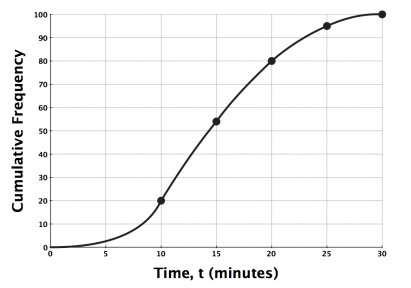How do you draw a cumulative frequency graph? (Part 1)
Given this set of data...
For cumulative frequency graphs, remember to plot your points at the TOP of each class boundary, DO NOT use midpoints.
See Part 2 of this card for the actual graph
| Time, t | Frequency | Cumulative Frequency |
| 0< t ≤10 | 22 | 22 |
| 10< t ≤15 | 32 | 54 |
| 15< t ≤20 | 26 | 80 |
| 20< t ≤25 | 15 | 95 |
| 25< t ≤30 | 5 | 100 |
For cumulative frequency graphs, remember to plot your points at the TOP of each class boundary, DO NOT use midpoints.
See Part 2 of this card for the actual graph
How do I calculate the estimated mean of grouped data?
Given this set of data for the test marks of a class of students, find an estimate for the mean test score of the class.
To actually calculate the mean...
Total of (frequency * midpoint) column ÷ Total Frequency
765 ÷ 23 = 33.3 (1 d.p.)
Always check your answer makes sense
| Mark (m) | Number of students | Midpoint | Freq x midpoint |
| 0<m≤25 | 4 | 12.5 | 4x12.5=50 |
| 25<m≤35 | 5 | 30 | 5x30=150 |
| 35<m≤40 | 8 | 37.5 | 8x37.5=300 |
| 40<m≤45 | 5 | 42.5 | 5x42.5=212.5 |
| 45<m≤60 | 1 | 52.5 | 1x52.5=52.5 |
| Totals: | 23 | 765 |
To actually calculate the mean...
Total of (frequency * midpoint) column ÷ Total Frequency
765 ÷ 23 = 33.3 (1 d.p.)
Always check your answer makes sense
How do I calculate mean from a frequency table?
A school recorded the number of days that Year 9 pupils were absent last week.
Calculate the mean number of days absent
To find the mean...
Sum of (number of days x number of pupils) ÷ Number of pupils
100÷200=0.5
Notice that no midpoints are needed as this is not grouped data.
Calculate the mean number of days absent
| Number of days | Number of pupils | No of days x No of pupils |
| 0 | 144 | 0x144=0 |
| 1 | 27 | 1x27=27 |
| 2 | 18 | 2x18=36 |
| 3 | 8 | 3x8=24 |
| 4 | 2 | 4x2=8 |
| 5 | 1 | 5x1=5 |
| Total: | 200 | 100 |
To find the mean...
Sum of (number of days x number of pupils) ÷ Number of pupils
100÷200=0.5
Notice that no midpoints are needed as this is not grouped data.
Key features of different graph types
Histograms:
No gaps between bars.
Frequency Histograms:
Equal bar widths.
Frequency as y-axis
Frequency Density Histograms:
Different bar widths.
Frequency Density as y-axis
Cumulative Frequency graphs:
Points plotted at top of class-boundaries.
Smooth curve through points.
Frequency Polygons:
Frequencies plotted at class mid-points.
Points joined with straight-lines.
No gaps between bars.
Frequency Histograms:
Equal bar widths.
Frequency as y-axis
Frequency Density Histograms:
Different bar widths.
Frequency Density as y-axis
Cumulative Frequency graphs:
Points plotted at top of class-boundaries.
Smooth curve through points.
Frequency Polygons:
Frequencies plotted at class mid-points.
Points joined with straight-lines.
Why is a 7-point moving average appropriate for the daily sales of a shop?
If you get a question, for example, asking why a 7-point moving average is appropriate, it's probably something to do with there being seven days in a week.
A 4-point moving average is often used for seasons (Autumn, Winter, Spring, Summer) because there are 4 of them.
Make sure you're answering the question though.
Why do we use a moving average?
is a different question to
Why is a 4-point moving average appropriate to this data?
For the second question, you must be specific as to why a four point moving average is used.
A 4-point moving average is often used for seasons (Autumn, Winter, Spring, Summer) because there are 4 of them.
Make sure you're answering the question though.
Why do we use a moving average?
is a different question to
Why is a 4-point moving average appropriate to this data?
For the second question, you must be specific as to why a four point moving average is used.

Flashcard set info:
Author: mrfoxton
Main topic: Mathematics
Topic: Handling Data
Published: 18.10.2009
Card tags:
All cards (14)
no tags




